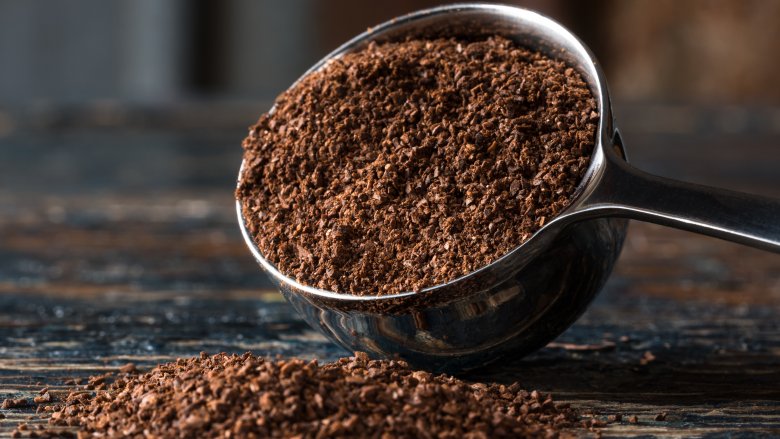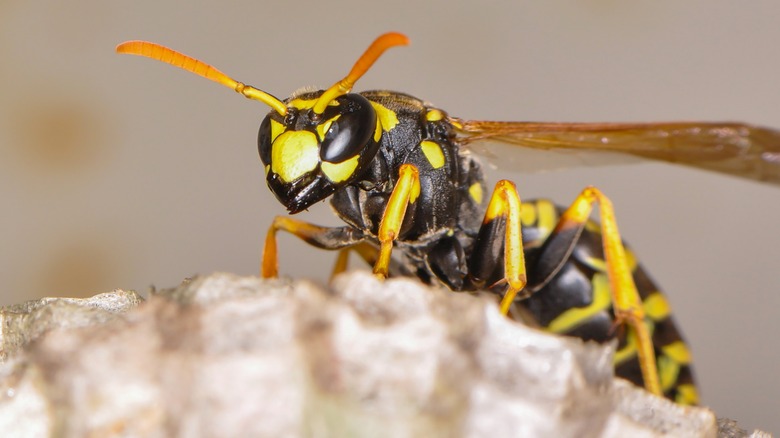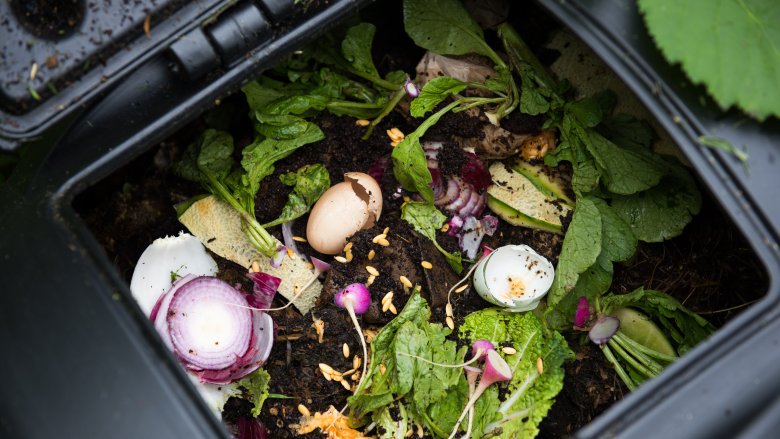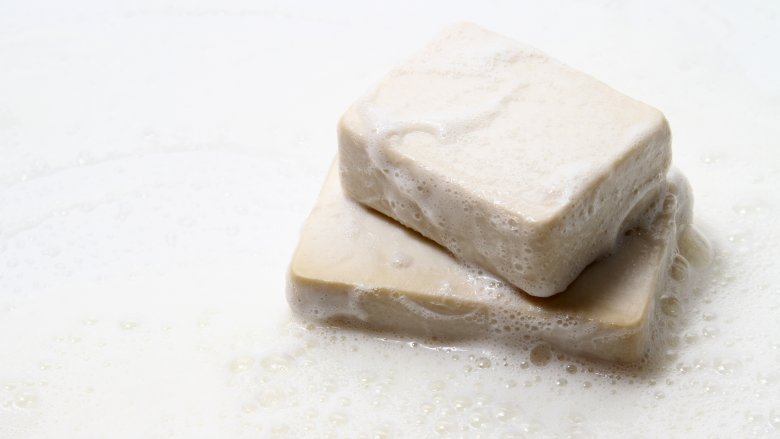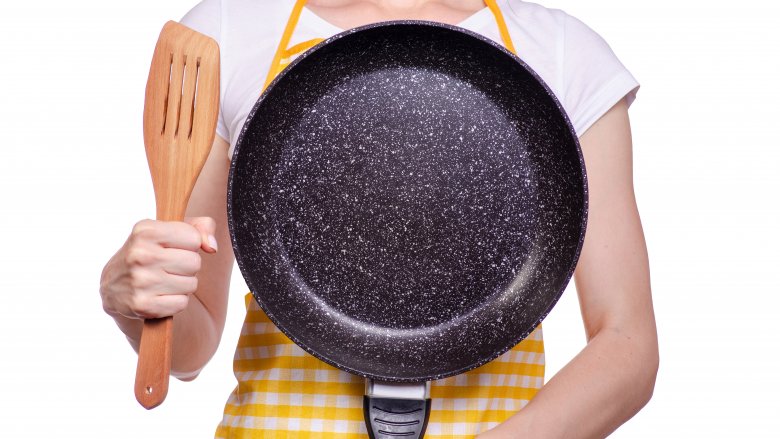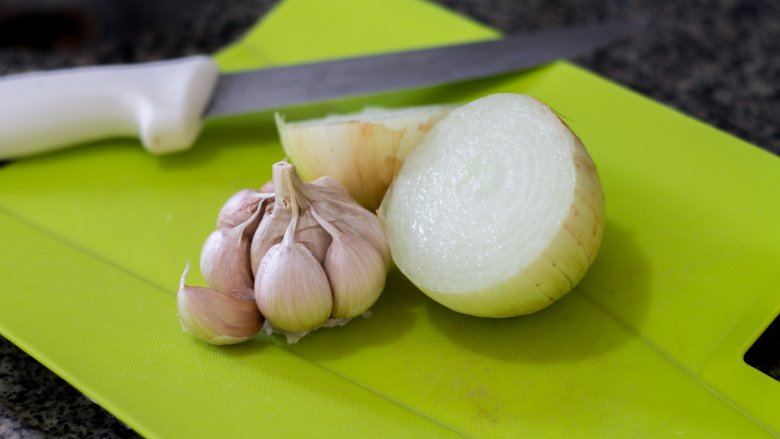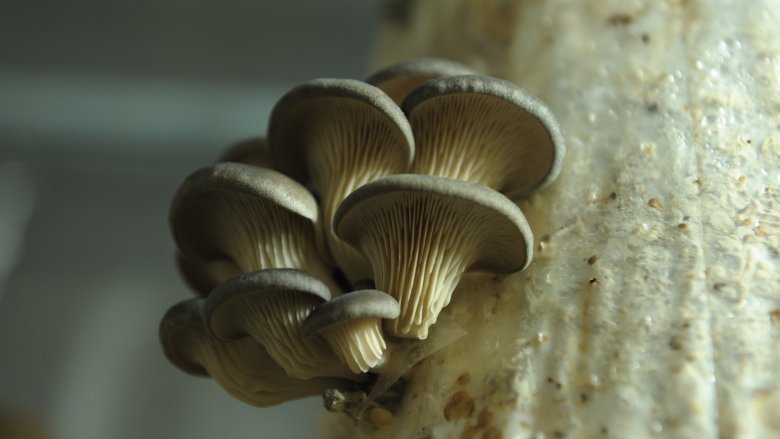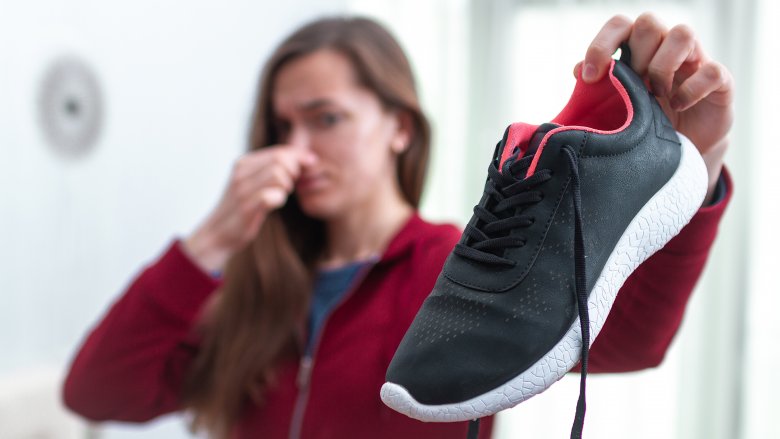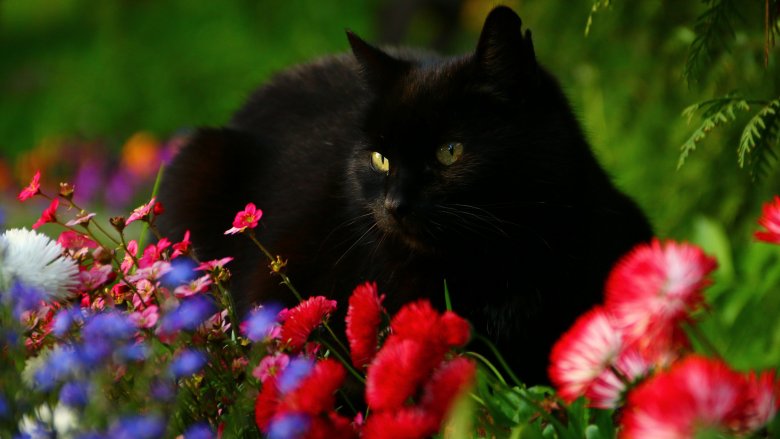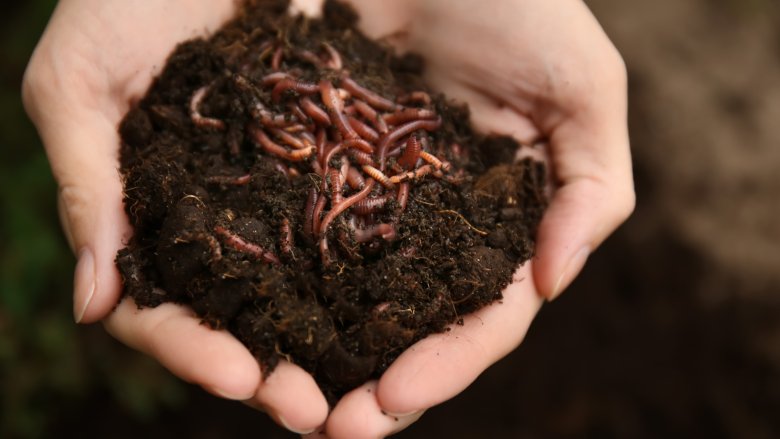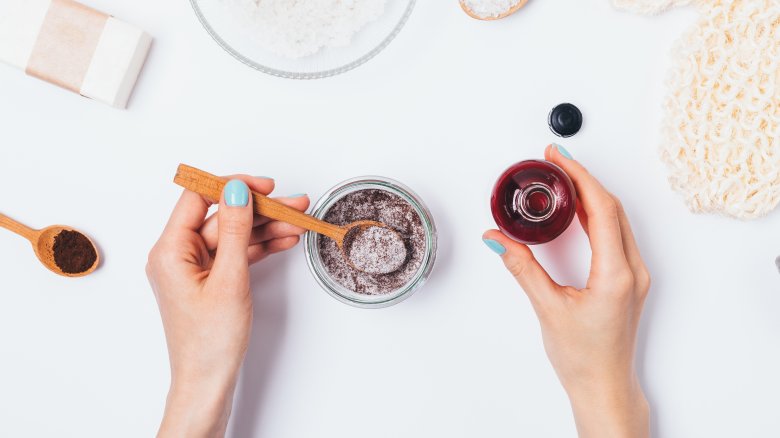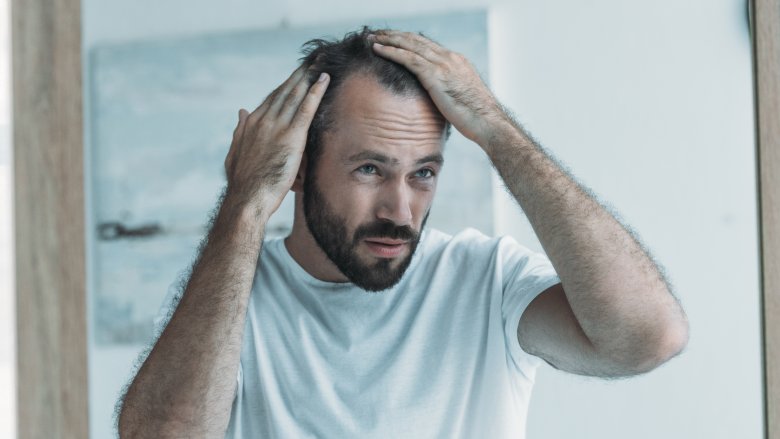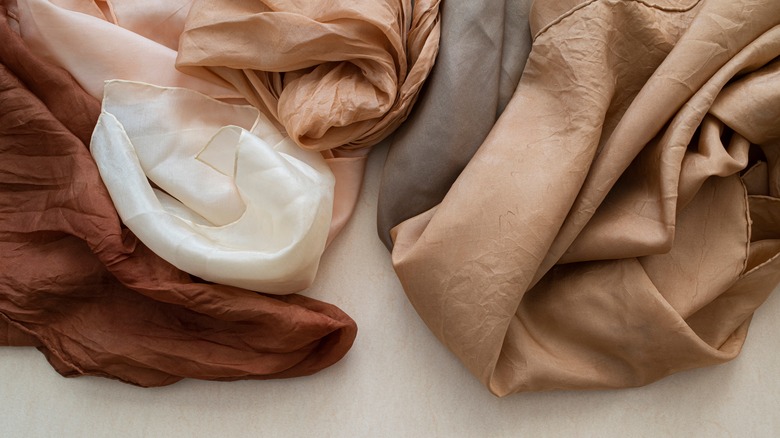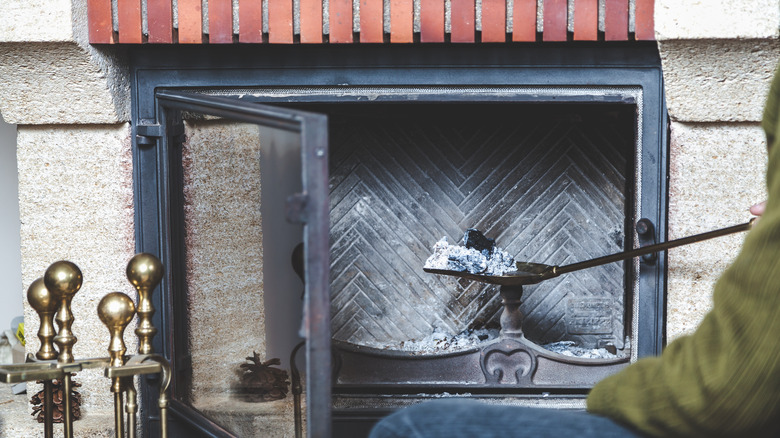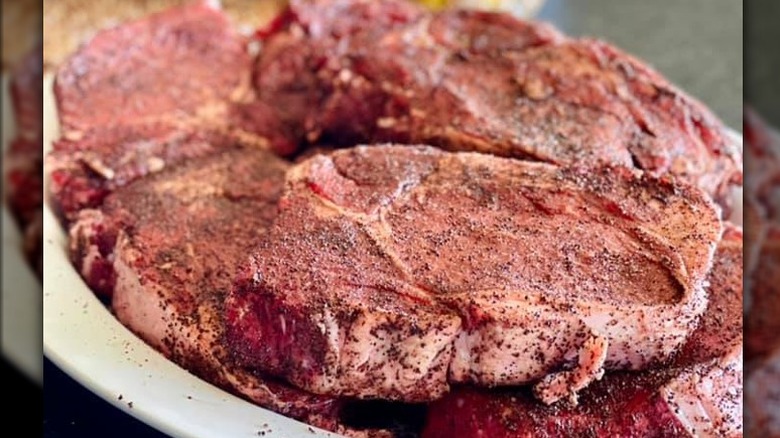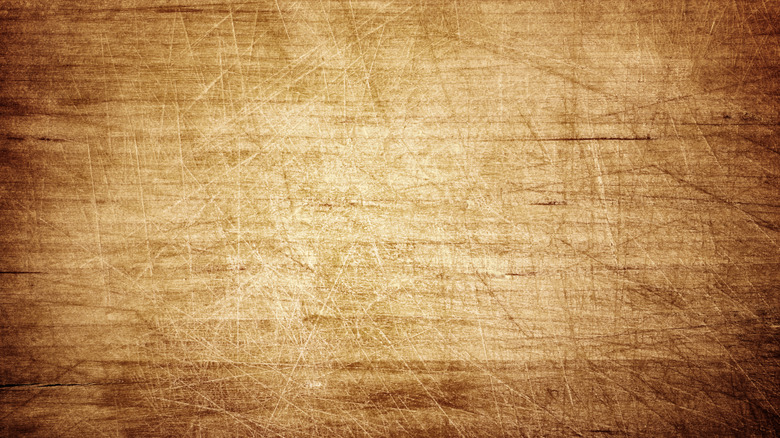The Real Reason You Shouldn't Throw Out Your Coffee Grounds
If you can't start your morning without a mug of coffee to perk you up, you are certainly not alone. According to a 2023 survey from the National Coffee Association, a whopping 65% of Americans over the age of 18 drink at least one cup of joe every day, and many of them probably chase it with a couple more to keep them going at work.
This is not surprising news, considering America's caffeinated culture, but what many people don't think about are the coffee grounds that are left behind once all of that liquid goodness has been squeezed out of them. Most people just toss them in the trash, but this is a mistake. You should never throw away your coffee grounds because they can be so much more than what they appear.
Coffee grounds can be used for everything from cleaning to gardening to beauty. So instead of chucking those grounds in the garbage tomorrow morning, start saving them up so you can do something much cooler (and less wasteful) instead.
Coffee grounds can help repel yard pests
Nobody hates walking out to their yard and seeing an invasion of wasps, mosquitoes, and ants. And if you have a garden, these and other pests can really put a damper on your green thumb. There is a solution though — coffee!
A 2015 study showed that mosquitoes (including those that carry serious, often deadly diseases such as Dengue) were not only repelled by coffee but also harmed by it. It should be noted, though, this was a highly concentrated coffee extract. Sprinkling coffee grounds in the dirt probably won't keep your yard mosquito free. That doesn't mean, however, you can't use coffee grounds to keep other pests at bay.
Coffee grounds can also make your home and yard unpleasant for pests such as ants, wasps, bees, slugs, and other insects that attempt to eat crops or garden vegetables. Simply lining the affected area with wet coffee grounds is usually enough to keep out the bugs that bug you, all without relying on harmful insecticides.
Start composting with coffee grounds
If you have been looking for a way to reduce your waste and help the environment at the same time, composting is a great way to start. To quote Kristin Hunt of GreenMatters.com, compost is simply a collection of "decayed organic matter." This organic matter can include things like leaves, egg shells, vegetable and fruit peels, and more. Over time, these organic materials begin to break down. When this happens, they turn into a fertilizer that is extremely high in nutrients, which you can then use to grow all new organic materials.
So where do the coffee grounds come in, you ask? Well they just might be the most important part. Studies have shown that when coffee grounds are mixed into a compost pile (especially when worms are present), the nutrient output is much higher. The coffee grounds help the other organic materials to break down into something even more useful and rich, meaning that the fertilizer that is created is even more effective at growing plants. Instead of tossing your used coffee grounds into the trash can, toss them into your compost bin — your garden will thank you.
Use coffee grounds to make exfoliating soap
If you have ever rubbed a dollop of coffee grounds between your fingers, you could probably see their exfoliating potential. While white and brown sugars are often used in homemade soaps and scrubs to help slough off dead skin, coffee grounds can actually be even more effective, thanks to their large grain size.
If you'd like to take advantage of that super skin-scrubbing power — or just make some really delicious-smelling soap — the process is simple. According to SoapQueen.com, all you will need is about one teaspoon of coffee grounds per one pound of soap. Once you have gathered these and patted them dry with a paper towel, the easiest way to use them is to make "melt and pour soap." This means that you melt a bar of soap, and then add the coffee grounds to the mixture. Stir, then pour into a mold of your choosing.
Once the soap has set up, it will be chock-full of natural exfoliants and the halos of golden brown around the coffee grounds will make it look beautiful as well. It is the perfect way to impress your houseguests or to give as a D.I.Y. Christmas gift.
While you're at it, use coffee grounds to scrub your pans
The coarseness of coffee grounds also makes them perfect for scrubbing out hard-to-clean pots and pans. Ground to Ground recommends letting the used coffee grounds dry in the sun, and then sprinkling them into your dirty stainless steel pans. After that, just use a cloth to move the grounds around, applying a firm but gentle pressure and a little elbow grease. The abrasive nature of the grounds makes cleaning a breeze, and your pot will be clean in no time, so you'll be ready to make an all new mess!
This method is particularly effective on pans that have stains or stuck-on food that just won't come off. In most cases, just one good scrub with the coffee grounds will have that stainless steel shining again. While damp grounds can still work, letting them dry completely first helps to break down the granules and turns them into an even better scrubbing tool.
Get rid of the smell on your hands after chopping onions or garlic with coffee grounds
Nothing tastes better than a dish made with onions and garlic. It fills the whole house with the delicious smell as they cook in the pan, and it makes everyone's mouths water as they wait for dinner time. The only problem is cutting the onions and garlic. As if it wasn't enough that the onions make you cry, they also make your hands stink, sometimes for days after cutting them. And it doesn't matter how many times you wash your hands! An oniony, garlicky aroma is perfect for sauces and sautés, but not so much for your fingers.
There are thousands of remedies and old wives' tales for this listed on the internet, all with varying levels of efficiency. If you ask Emily Han of Kitchn, though, there is one clear winning strategy: coffee grounds. The procedure is simple: just grab a handful of used coffee grounds and rub them into your fingers and fingernails until the onion and/or garlic smell is gone. Then wash your hands and go enjoy the delicious meal you made, knowing that you smell great too (and not like a giant garlic clove).
Start a mushroom farm with coffee grounds
Mushrooms can be a delicious addition to your dinner menu, but they tend to be a bit on the expensive side. Luckily for all the fungi lovers out there, there is a way to get all the mushrooms you want without even leaving your house.
According to FiveGallonIdeas.com, all you need to start your own mushroom farm is a five-gallon bucket, a handful of oyster mushroom spawn, and coffee grounds. Simply fill the bucket halfway up with moistened coffee grounds and mix in the mushroom spawn (you can find some on Amazon). Drill some holes into the sides of the bucket to let your homemade substrate breathe, and cover the bucket with plastic wrap (with a few holes punched in it).
Keep the coffee grounds moist by spritzing them with water twice a day and make sure to keep your mini farm out of direct sunlight. Then, if you've done everything right, you should start seeing mushroom sprouts very soon. Once you harvest them, the mushrooms are safe to eat, so you can make all the mushroom risotto you want.
De-funk your stinky gym shoes with coffee grounds
Whether you are male or female, big or small, muscular or still working on it, everyone's gym shoes and walking shoes get stinky. Most of the time you can only smell the offensive odor when you're safe at home and take off the shoes, but other times it gets to the point where the people around you start to pick up on the scent. So what's a stinky-footed person to do?
Coffee grounds are a terrific natural deodorizer. They absorb and eliminate odors and can be used for this purpose in shoes. The cause of foot/shoe odor is a buildup of bacteria that thrive in the hot, humid environment of your sneaker. To kill this bacteria, simply fill a coffee filter or a nylon stocking with coffee grounds and stuff it into your shoe. Let it rest there for 24-48 hours, and voila! Your shoes are fresh and ready to run again without making your neighbors turn up their noses.
Use coffee grounds to keep Kitty from using your garden as a litter box
No matter how much you love your cats (or the stray cats from the neighborhood), there is nothing cute about them using the bathroom in your garden. Cats love to use gardens as litter boxes, but while some animal feces is good for a garden (think horse and cow manure), cat poop is a great way to kill your plants and make your vegetables inedible.
Cat feces is toxic, and you don't want that in your plants. Furthermore, there are some garden plants that can be toxic to the cats as well, so the best course of action is to keep Garfield out of your garden altogether. But how can you accomplish this without building a greenhouse with a big, sturdy lock on the door?
The answer is in your coffee pot. Sprinkling coffee grounds in the garden not only helps to make your soil more healthy, but it also repulses cats. They can't stand the smell of them, and it sends them running to find some other place to do their business.
Deodorize your fridge and freezer with coffee grounds
Science has repeatedly shown that coffee grounds are a key ingredient to eliminating odor — including the odors in your refrigerator or freezer. Just like with the sneakers, the fix is simple, and you probably have everything you need right there in your kitchen.
Both fridges and freezers have a tendency to trap odors inside, such as onions or meat or just a general smelly staleness composed of little bits of all the leftovers you have stored in there. Getting rid of these smells just takes a few minutes of work, though, and a few spoonfuls of coffee grounds. According to LifeHacker, after patting some used coffee grounds dry, you can fill a nylon bag or stocking with them or place them in an open bowl. Place the bag or bowl in the back of the offending appliance, and they will slowly dry out, making the fridge smell like coffee instead of something unpleasant.
The de-stinkification process should only take a few days, and in the meantime you can enjoy the much better aroma of coffee whenever you open the door to get a snack.
Love fishing? Coffee grounds help ensure you always have worms on hand
If you happen to know any Italian, you might have heard that "vermi" means "worms." So, "vermicomposting" means composting with worms. Composting is a method of breaking down organic materials that creates a rich fertilizer than can be used to grow plants. Vermicomposting can serve this same purpose — or it can just help you make sure you always have worms to go fishing with!
According to experts from Cornell University (via SFGate), putting down a layer of coffee grounds in your compost pile is a fantastic way to attract worms. Worms like to eat many of the same types of foods that we do, and it turns out that they are coffee fiends too. The grounds help their gizzards digest the rest of the things they eat, and this enables them to produce more nutrient-rich waste that helps your compost pile and keeps them happy and healthy and ready to attract some big, hungry fish. So even if you don't have a garden that will benefit from composting, it will help you plan a last-minute fishing trip without having to stop for bait.
Use coffee grounds to decrease cellulite
Everyone should feel comfortable in their own skin, but when it comes to cellulite, you probably think less is more. Cellulite is tough to get rid of, and 90% of women get it in their lifetime, per Scientific American. While it is nothing to be worried or ashamed about (it's just fat deposits pushing through the collagen beneath your skin and causing dimples and lumps), most women wish they could banish it as quickly as possible.
Luckily there is a way to do this, and you've had it in your kitchen all along. Caffeine has been proven to reduce the appearance of cellulite by increasing circulation and breaking up the lumps that form under the skin. This leads to smoother, softer-looking skin that will have you more than ready to jump back into that bathing suit.
When you're ready to make that cellulite disappear, Elle recommends starting with a bit of light exfoliation. Then mix some coffee grounds with some coconut oil to make a nice, heavenly smelling homemade scrub, then head into the shower (it's less messy this way). Make it a part of your regular shower routine to rub the coffee ground scrub in a circular motion on every place you have cellulite. Then rinse and repeat the next time you have a shower to get that flawless skin you always wanted.
Make a coffee scrub to regrow lost hair
Caffeine, being the miracle of miracles that it is, has been shown to help men (and women!) regrow lost hair. In a study in which caffeine was applied to the scalps of people with alopecia, it was shown to enlarge the root of the hair, elongate the growth stage of the hair, and cause the area to produce more keratin for even more hair growth. What's more, the effects were very nearly immediate and long-lasting. Even after 120-192 hours, the hair was continuing to exhibit more growth than the untreated hair.
Skeptical? You can try this seemingly miraculous hair growth treatment at home by creating a thick paste made from coffee grounds and the oil of your choice. Then rub the mixture into the roots of your hair for 5-10 minutes under the shower and rinse. Follow up with your normal shampoo, then go out and buy a new hairbrush because you're going to need it!
Use coffee grounds as a natural fabric dye
Looking for the perfect mocha-colored shirt? Trying to give a stained tablecloth a second life? Your coffee pot might hold the solution to your problem. Coffee grounds can be used as an all-natural, environmentally friendly fabric dye.
According to Italian coffee company Gaggia, there are two ways to use coffee grounds to dye fabrics — the boiling method and the dry method. The former requires heating the grounds and a spoonful of salt in water. Once the water comes to a boil, turn off the heat and immerse the fabric in the water for at least one hour. For the best result, rinse with cold water then put the fabric back in the pot along with some white wine vinegar. Ten minutes later, the fabric will be ready to dry. To follow the dry method, create a coffee paste by combining the grounds with water and mixing well. Spread the paste over the fabric using a wooden spoon to help push the coffee deep into the fibers. Let the fabric dry in sunlight before brushing off the coffee grounds (a toothbrush will help).
With either method, the more coffee you use, the darker the fabric will end up. Gaggia also notes that coffee grounds should only be used as a dye on fabrics made of natural fibers, such as cotton and wool. Synthetic fibers don't absorb color well, which can result in a splotchy dye job.
Use coffee grounds to clean your fireplace
If you're lucky enough to be able to enjoy fireside evenings from the comfort of your own living room, you have likely also experienced the downside of having an in-house fireplace: the cleanup.
Cleaning a fireplace is not particularly difficult in and of itself, but it can be a health risk to some. Because ashes are so light in weight, they will often fly up into the air when you try to sweep them away. Inhaling these particles can affect your breathing and is particularly dangerous if you suffer from asthma or another respiratory condition.
So, how does coffee help? Sprinkling coffee grounds inside your fireplace helps weigh the ashes down, preventing them from becoming airborne and ending up in your lungs. It's best if the coffee grounds are damp. This adds more weight and makes the coffee and ashes more likely to stay on the ground. Bonus tip: Leaving a layer of coffee grounds in the fireplace after cleanup will help absorb any unwanted odors.
Use coffee grounds to tenderize and marinate meat
If your spice rack is barren but you're craving a delicious steak, look no further than your coffee pot. Among its many other uses around the kitchen, coffee is also an excellent meat tenderizer and marinade.
Coffee grounds can help create the perfect piece of meat in three ways. First, the coffee's acidity acts as a natural tenderizer, helping to break down the protein's tough muscle fibers. Those same acidic compounds also add intense flavors, much the same way a bold-flavored wine does to other meals. Finally, the coffee grounds will form a crust around the piece of meat, sealing in the flavor and moisture while it cooks. The end result is a juicy, tender, intense-flavored entrée.
"The best steak I've ever had was in Milwaukee, Wisconsin, at a supper club, and it had the most delicious crust and [was] perfectly pink-medium on the inside," recipe developer Michelle McGlinn told Tasting Table. "They achieved that with extremely high-temp cooking far beyond what any home cook can do. [A coffee-rubbed steak] is a really easy way to achieve a similar crust because the sugars and coffee grounds caramelize and crisp so beautifully over the heat."
Remove furniture scratches with coffee grounds
No matter how well kept a home is, wooden floors and furniture are bound to get scratched up eventually. And when that happens, repairing them can be a costly expenditure — unless you have some leftover coffee grounds lying around.
"A little trick I've used is to cover scratches by applying some used coffee grounds with a cotton swab," furniture expert Daniel Craig told Homes & Gardens. "Let the grounds sit on the scratches for 10 minutes and then wipe away gently. It really works."
Some professionals suggest first mixing the coffee with water to make a paste or steeping the grounds for an hour in equal parts water and vinegar to make a solution that can then be applied to the wood. Whether dry or wet, the coffee grounds should do the trick of obscuring the scratch. "Both methods darken the scratch and make it less noticeable," decorator Andre Kazimierski said (via Homes & Gardens). Whichever way you choose to repair the wood, make sure the color of the coffee matches by first applying the grounds to a concealed part the furniture or floor to see how it looks.
